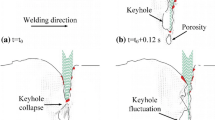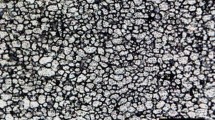Abstract
The formation and stability of keyhole in stationary laser welding on aluminum metal matrix composites reinforced with particles are studied using a numerical simulation. The interaction between molten pool and reinforcement particles is evaluated by using the particle–fluid coupling model in the numerical simulation. In order to study the effect of different volume fractions of particles on the keyhole stability and fluid flow inside the molten pool, keyhole formation process, variation of free surface, temperature distribution, and fluid flow are calculated numerically, respectively. The calculation results show that the keyhole is stable at the beginning under different conditions and then the protrusion occurs inside the keyhole with increasing calculation time. The flow behavior of molten pool affected by particles and forces acting on the surface could explain the forming of humps inside the keyhole, which directly cause the variation of the keyhole. As the volume fraction of TiB2 particles increases, the keyhole is more likely to be instable and the oscillation occurs at an earlier time. Fluctuations of the surface tension and recoil pressure due to the uneven distribution play an important role in the instability of the keyhole.
Similar content being viewed by others
References
Gibilaro LG, Felice RD, Waldramand SP, Foscolo PU (1985) Generalized friction factor and drag coefficient correlations for fluid-particle interactions. Chem Eng Sci 40:1817–1823
Yuan Q, Brain GT, Vanka SP (2004) Study of transient flow and particle transport in continuous steel caster molds: Part I. Fluid Flow Metall Mater Trans B 35:685–702
Cho JH, Farson DF, Milewski JO, Hollis KJ (2009) Weld pool flows during initial stages of keyhole formation in laser welding. J Phys D: Appl Phys 42:175502
Klemens PG (1976) Heat balance and flow conditions for electron beam and laser welding. J Appl Phys 47:2165
Kroos J, Gratzke U, Simon G (1993) Towards a self-consistent model of the keyhole in penetration laser beam welding. J Phys D: Appl Phys 26:474–480
Fabbro R (2010) Melt pool and keyhole behaviour analysis for deep penetration laser welding. J Phys D: Appl Phys 43:445501
Akira M, Vlad S (1997) The simulation of front keyhole wall dynamics during laser welding. J Phys D: Appl Phys 30:798–809
Pang SY, Chen LL, Zhou JX, Yin YJ, Chen T (2011) A three-dimensional sharp interface model for self-consistent keyhole and weld pool dynamics in deep penetration laser welding. J Phys D: Appl Phys 44:025301
Lee JY, Ko SH, Farson DF, Yoo CD (2002) Mechanism of keyhole formation and stability in stationary laser welding. J Phys D: Appl Phys 35:1570–1576
Solana P, Negro G (1997) A study of the effect of multiple reflections on the shape of the keyhole in the laser processing of materials. J Phys D: Appl Phys 30:3216
Fabbro R, Chouf K (2000) Keyhole modeling during laser welding. J Appl Phys 87:4075
Yang J, Wang FD (2009) 3D finite element temperature field modelling for direct laser fabrication. Int J Adv Manuf Technol 43:1060–1068
Semak V, Hopkins J, McCay M, McCay T (1995) Melt pool dynamics during laser welding. J Phys D: Appl Phys 28:2443–2450
Semak V, Matsunawa A (1997) The role of recoil pressure in energy balance during laser materials processing. J Phys D: Appl Phys 30:2541
Gao ZG, Wu YX, Huang J (2009) Analysis of weld pool dynamic during stationary laser-MIG hybrid welding. Int J Adv Manuf Technol 44:870–879
Kaplan A (1994) A model of deep penetration laser welding based on calculation of the keyhole profile. J Phys D: Appl Phys 27:1805–1814
Liang GL, Zhou G, Yuan SQ (2009) Study on hybrid heat source overlap welding of magnesium alloy AZ31B. Mat Sci Eng: A-Struct 499:93–96
Zhao H, Niu W, Zhang B, Lei Y, Kodama M, Ishide T (2011) Modelling of keyhole dynamics and porosity formation considering the adaptive keyhole shape and three-phase coupling during deep-penetration laser welding. J Phys D: Appl Phys 44:485302
Wang J, Guo Q, Nishio M, Ogawa H, Shu D, Li K, He S, Sun B (2003) The apparent viscosity of fine particle reinforced composite melt. J Mater Process Tech 136:60–63
Author information
Authors and Affiliations
Corresponding author
Rights and permissions
About this article
Cite this article
Meng, C., Lu, Fg., Cui, Hc. et al. Research on formation and stability of keyhole in stationary laser welding on aluminum MMCs reinforced with particles. Int J Adv Manuf Technol 67, 2917–2925 (2013). https://doi.org/10.1007/s00170-012-4704-0
Received:
Accepted:
Published:
Issue Date:
DOI: https://doi.org/10.1007/s00170-012-4704-0




